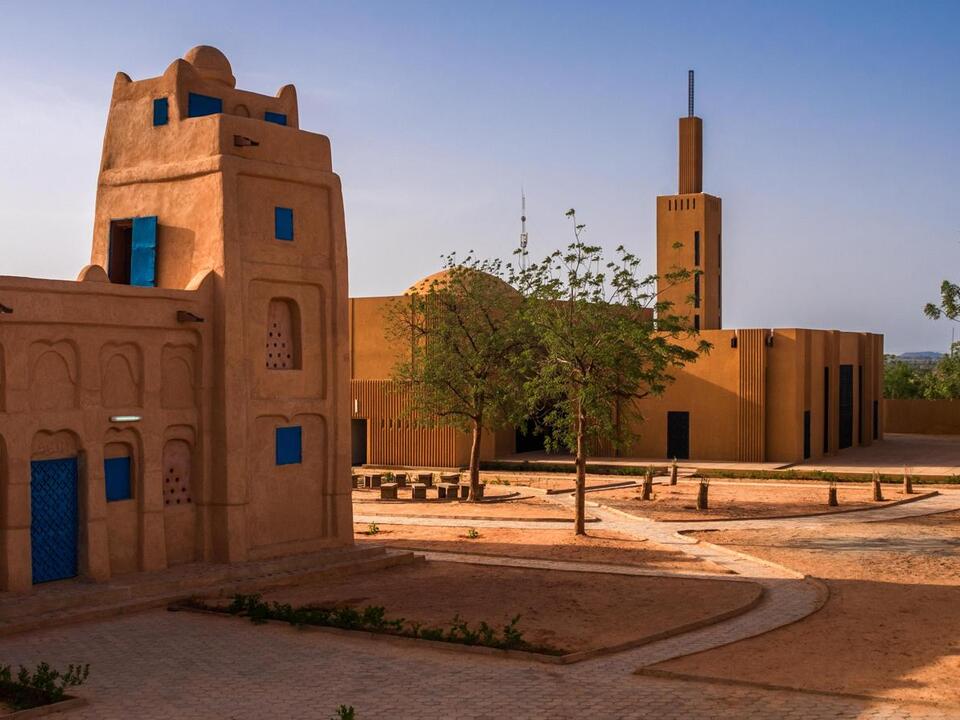Physical Address
304 North Cardinal St.
Dorchester Center, MA 02124
Physical Address
304 North Cardinal St.
Dorchester Center, MA 02124

Growing up near the historic mud-brick city of Agadez, Niger’s gateway to the Sahara, Mariam Issoufou was always inspired by the majestic adobe structures around her. The city’s mosque, with its 27-metre-high minaret—the tallest mud-brick structure in the world—has stood on the horizon since the 16th century. However, she never imagined she could become an architect and build such things herself.
“There were no role models,” she recalls. “I didn’t know of any architects in Niger, let alone any women in the field.”
In the 1990s, she had the opportunity to study in the US. It was the dawn of the tech era, and computers seemed like the most promising route to a stable career. “So I became a software engineer. I worked in the industry for almost 10 years and didn’t like a minute of it.”
Just over a decade since leaving the tech world and retraining, Issoufou has established herself as one of Africa’s most sought-after architects. She has built a prize-winning library and mosque complex in the Nigerien village of Dandaji and a celebrated earth-walled housing complex in Niamey, which was shortlisted for the Aga Khan award.
Currently, she is working on a museum in Senegal and a presidential centre in Liberia, along with projects in Sharjah and Brazil. In addition, she holds a role as a professor at ETH Zürich, juggling offices between there, Niger, and the US.
“Because I came to architecture as a second career, I was more mature and incredibly single-minded about where to direct my energies,” she says from her new studio in New York City. “I knew exactly what types of problems I was interested in.”
Issoufou’s work is defined less by a single style and more by hard-nosed pragmatism, aiming to make the best use of locally available resources, whether materials or skills. Growing up in one of the poorest, hottest countries in the world—where 45% of people live below the poverty line and temperatures can exceed 45C—she found it baffling that the local built environment aimed to emulate the west.
“Our built environment is shaped by the idea that progress must look like the western world,” she says. “That’s the only image of progress we have, and unless we achieve that, we’re somehow lacking. I found that incredibly insulting, and it didn’t make sense.”
Issoufou knew from personal experience how well mud-brick buildings functioned in the desert climate, shielding interiors from the scorching sun during the day and releasing heat at night when temperatures drop. Realizing that earth was the most cost-effective and sustainable solution for construction, maintenance, energy consumption, and local availability, she faced an uphill battle convincing her clients.
“I have to reassure them that I’m not trying to send them back in time 200 years,” she says. “Ironically, I have to show them examples of earth architecture in Europe for reassurance. We still defer to European standards as the authority, which is profoundly unfortunate.”
The housing project in Niamey, designed with the collective united4design, offers a powerful proof of concept. The six courtyard homes, built on a plot that would usually house a single family compound, are a model for how the city could densify to avoid relentless sprawl. Built with unfired earth bricks and designed around passive ventilation principles, they are 10 degrees cooler indoors than outside—whereas an equivalent concrete building would require air conditioning to be habitable.
“Some months, as much as half of a person’s pay could go to the electricity bill because of AC,” Issoufou explains. “Using earth isn’t just better for the environment but also for sustaining the economic life of the building, the people using it, and those involved in constructing it. Sustainability has to be seen as a multilayered, intersectional thing.”
Issoufou believes the term “sustainability” has been abused, driven by an industry that mandates expensive, box-ticking add-ons, which are energy-intensive to produce and not genuinely sustainable for most of the world.
She takes a reverse approach to the global architecture industry’s norm. “I don’t do a design and then find who could build it,” she says. “I try to figure out who is there and what they know how to do. And then I design, keeping that in mind.”
Each project begins with extensive research, “excavating the past of the place and understanding the practices that are currently thriving,” before any design process starts.
In Monrovia, the capital of Liberia, Issoufou is designing the Ellen Johnson Sirleaf Presidential Center for Women and Development, named after the country’s first woman president. The complex consists of a cluster of tall, steeply pitched blocks inspired by traditional palava huts, whose exaggerated roofs manage Liberia’s heavy rainfall.
Inside, steep timber roofs will be lined with woven palm leaf mats made by local women, whom Issoufou saw weaving baskets along roadsides all over the city. “Rather than importing materials,” she says, “we are using raw earth bricks, fired clay bricks, rubberwood, and palm leaves—all things that local builders and craftspeople know how to do, helping promote economic sustainability.”
In the Senegal region of Kaolack, Issoufou initially hesitated to take on a project for the new Bët-bi museum, commissioned by Le Korsa, part of the Josef and Anni Albers Foundation. Museums had always made her feel uncomfortable. Museums are often seen as temples of culture intended to elevate and educate, a behavior learned from a certain place in the world.
“Museums came to be because of colonization and empire expansion, needing to showcase plundered objects. In Africa, everyone complains that museums are built and then left empty, with no one visiting. But it makes sense that, as a colonized people, we would have no interest in them.”
She observed that successful cultural buildings in Africa often feature public spaces outside. “I’ve seen examples in Niger of massive museums that no one visits, but the outside landscape is full of people picnicking under trees and having a great time together.”
In response, Issoufou decided to bury the Senegal museum, making it secondary to inviting public spaces that lead visitors toward the galleries through glimpses of what lies below ground.
The triangular form of the museum was inspired by the Indigenous Serer people, who have a mystical relationship with natural elements. The sun, wind, water, and ancestral spirits are defined by triangles between the living and the dead, with the sunken collections referencing ancestral burial practices.
“I’m trying to avoid the wilful grandness of a museum, which can be incredibly intimidating,” says Issoufou. “People will hopefully be seduced inside by seeing the content through apertures as they go down the ramp. But there’s no pressure to go inside if they don’t want to.”
Back in Niger, a project for an earth-brick office building was nearing completion last year when the country experienced a military coup in July. Although the building is slowly getting back on track, Issoufou’s project for a cultural centre in Niamey, featuring elliptical earth-brick towers, now seems unlikely to be realized.
“The city worked really hard to find the funding, and we were two months away from breaking ground,” she says. “But we have much bigger problems at this point.”
Despite these challenges, she remains optimistic about both the country and the continent’s future. “It feels like we’re experiencing a second independence. We’re seeing innovation in every arena in Africa, from fashion to banking, aiming to find solutions that reflect our realities and identities.
“There’s a lot to be built still: we have this amazing canvas, waiting to be painted.”
Source: The Guardian



